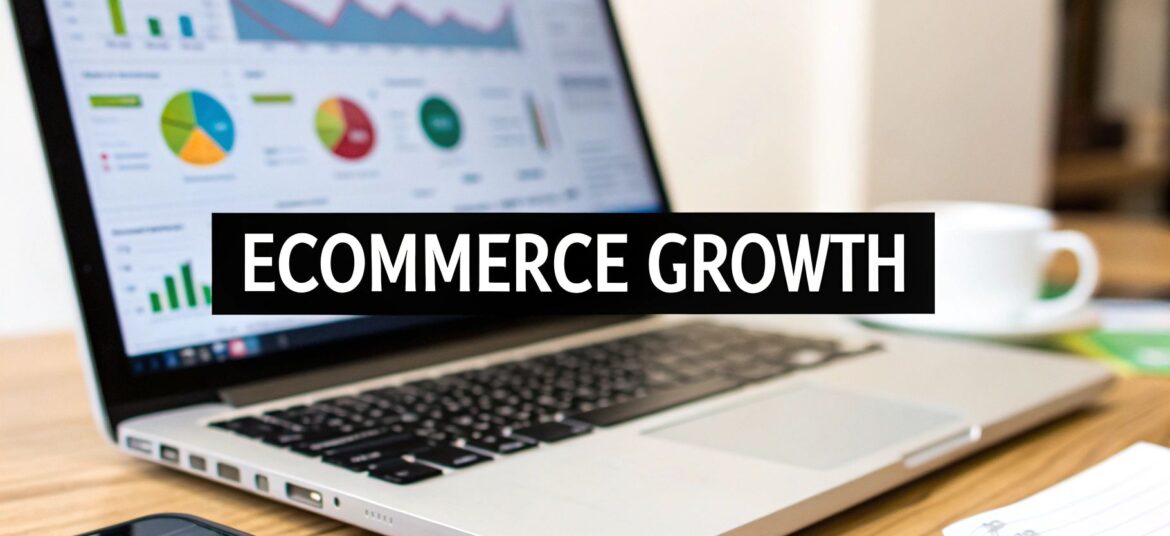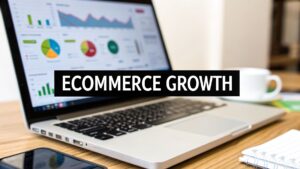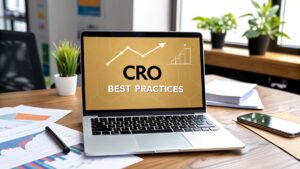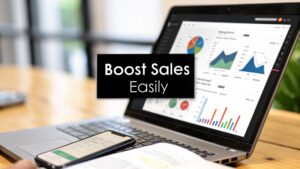Feeling like your Shopify store’s hit a bit of a wall? You’ve built something brilliant, but now you’re facing the real challenge: how to actually scale it. We’ve been there. As a hands-on Shopify team, we’ve worked with countless brands who feel stuck at that exact point. Your early momentum has slowed, sales have flattened out, and you’re left scratching your head, wondering, “what’s next?”
The good news is, breaking through this plateau isn’t about finding some secret, one-size-fits-all solution. It’s about strategically using a handful of proven ecommerce growth strategies that genuinely move the needle. This is where we come in. Forget the vague advice and jargon-heavy guides that leave you with more questions than answers.
We’re here to have a proper chat, like we would with a client over coffee, about the 10 real-world tactics we consistently use to accelerate growth. These are the strategies we’ve tested, refined, and seen deliver real, tangible results for our partners, time and time again. We’ll walk you through practical steps for everything from mastering SEO to leveraging social commerce. Ready to get practical and start seeing some real movement? Let’s dive in.
1. Master Your Organic Reach with Practical SEO
Paid ads get you quick wins, but Search Engine Optimisation (SEO) is your long-term ticket to free, high-intent traffic. Think of it this way: a solid SEO strategy gets your products in front of people who are literally typing into Google that they want to buy what you sell. It’s a marathon, not a sprint, but the payoff is huge.
When we onboard a new client, one of the first things we do is a deep dive into their on-page and technical SEO. It’s the foundation for everything else. We look at optimising product and category pages to capture both specific and broad searches, making sure the site is technically sound for Google, and building a content plan that shows you’re the experts. Done right, SEO builds a powerful, sustainable engine for growth that works for you 24/7.
Why It’s a Top eCommerce Growth Strategy
Unlike paid ads, where the traffic stops the second you stop paying, SEO builds on itself. The authority you build and the rankings you earn become lasting assets for your business. This strategy is perfect for brands aiming for sustainable, long-term growth and a lower customer acquisition cost over time. Brands like REI have mastered this, creating a content hub that not only ranks for gear but also for guides on how to use it, capturing customers at every stage of their journey.
How to Implement SEO on Your Shopify Store
Getting started with practical SEO doesn’t mean you have to overhaul everything. We’d tell a client to begin with these fundamentals:
- Focus on long-tail product keywords: Instead of just “running shoes,” target something like “best trail running shoes for wide feet.” These longer, more specific phrases have less competition and are used by people who are much closer to buying.
- Optimise product images: Use descriptive alt text (e.g., “Nike-Pegasus-40-mens-running-shoe-in-blue”). This helps Google understand your images and rank them in image searches, which is a surprisingly powerful source of traffic.
- Implement structured data: This is a bit more technical, but it’s a game-changer. Use a Shopify app or work with a developer to add schema markup. This helps Google create “rich snippets” (like ratings and stock levels) right there in the search results, which can massively improve your click-through rate.
The following graphic summarises the powerful, long-term impact of a well-executed SEO growth strategy.
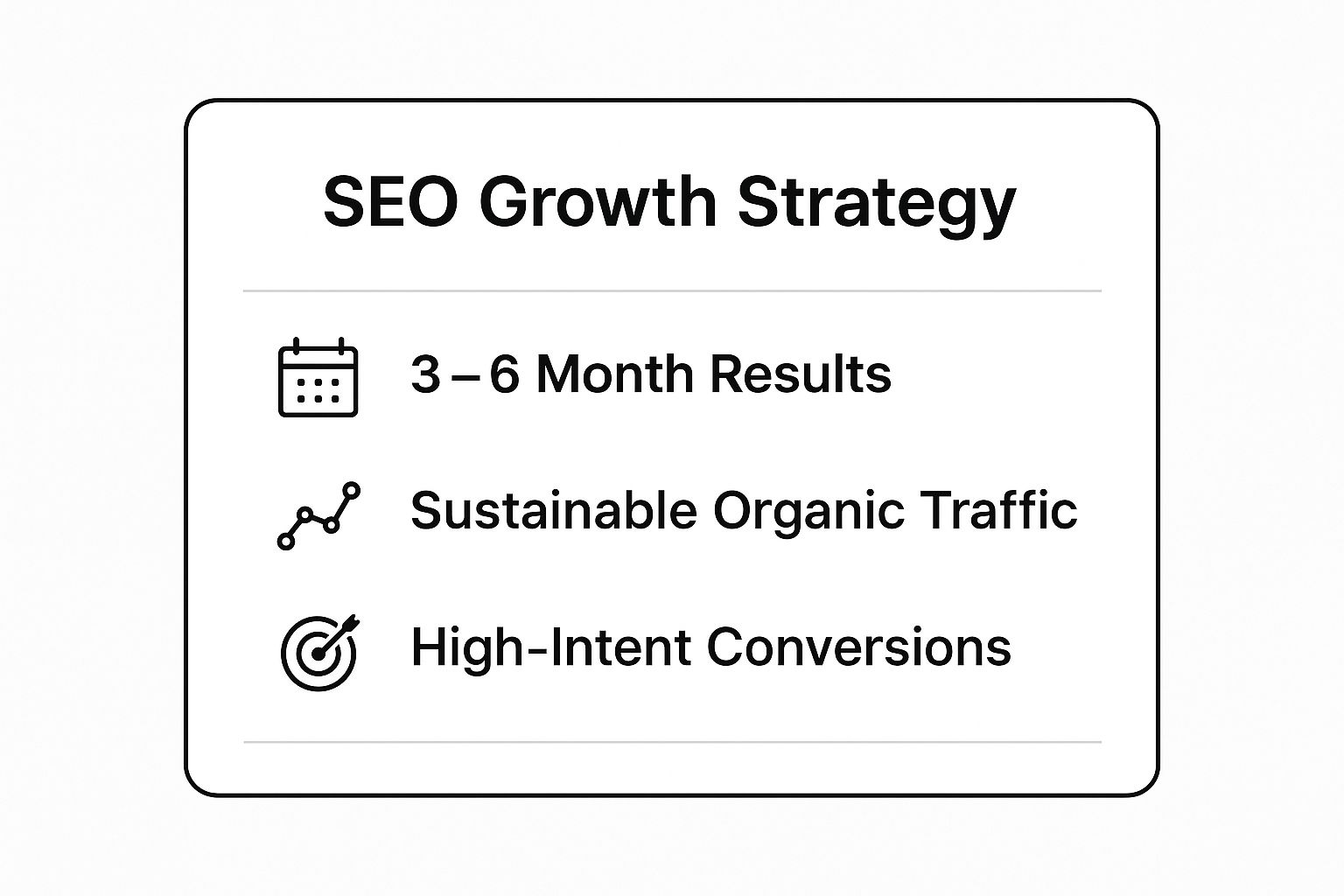
As you can see, the value lies in its sustainability; it’s designed to deliver consistent, high-quality traffic that converts well beyond the initial effort.
2. Email Marketing Automation
Email isn’t just for order confirmations; it’s one of the most powerful revenue channels you actually own. An automated email strategy lets you nurture customer relationships at scale by sending the right message at the right time, all triggered by what they do on your site. It’s about creating a personalised journey that guides subscribers from first-time visitors to loyal, repeat buyers.

When we work with Shopify stores, setting up core automated emails, or ‘flows’, is a top priority. We start with the essentials: a compelling welcome series for new subscribers, a high-converting abandoned cart sequence, and a post-purchase follow-up to build loyalty. These automated systems work tirelessly in the background, converting leads and increasing customer lifetime value without you lifting a finger. For a deep dive into a platform that excels at this, explore more about Klaviyo for Shopify.
Why It’s a Top eCommerce Growth Strategy
Unlike social media, your email list is an asset you fully control, free from the whims of algorithm changes. This strategy is perfect for brands wanting to build direct relationships and maximise repeat purchases. It delivers an incredibly high return on investment by turning one-time buyers into lifelong fans. Brands like Sephora are brilliant at this, using purchase history to send tailored beauty tips and product recommendations that feel personal and drive repeat sales.
How to Implement Email Marketing Automation on Your Shopify Store
Getting started with automation is pretty straightforward with platforms like Klaviyo. Our advice? Focus on these key flows first:
- Set up a fast abandoned cart flow: Trigger the first email within one hour of a cart being abandoned. This is the golden window to recover a potential sale. Make sure it includes an image of the item and a clear, simple button to complete the purchase.
- Segment your lists: Don’t send the same email to everyone. We create segments based on purchase behaviour (e.g., first-time buyers, VIP customers, lapsed customers) to send highly relevant campaigns that actually resonate.
- Use dynamic product recommendations: Automatically populate emails with products a customer is likely to be interested in based on what they’ve browsed or bought before. This personal touch significantly boosts clicks and conversions.
3. Harness the Power of Social Media Marketing
Social media is no longer just a place to post pretty pictures of your products; it’s a dynamic ecosystem for building a brand, chatting with customers, and driving direct sales. For a modern ecommerce brand, a multi-platform social strategy is all about creating a community and telling your story where your audience spends their time.
When we develop a social media plan for a client, we focus on creating a consistent brand narrative that’s adapted for each platform. Whether it’s visual storytelling on Instagram, educational content on TikTok, or community building in a Facebook Group, the goal is always to create authentic connections that lead to sales. This approach transforms passive followers into proper brand advocates.
Why It’s a Top eCommerce Growth Strategy
Social media offers an incredible opportunity to build direct relationships with customers at scale. It lets you gather real-time feedback, foster loyalty, and use customer photos and videos (user-generated content) as powerful social proof. Glossier built an empire by cultivating an Instagram community that felt like an exclusive club, turning customers into their most effective marketers. This strategy is essential for brands that thrive on community, visual appeal, and direct relationships.
How to Implement Social Media Marketing on Your Shopify Store
A successful social media presence needs a strategic, consistent effort. Here’s how we’d approach it with a client:
- Create a content calendar: Plan your posts in advance to ensure a consistent flow. Mix product promotions with behind-the-scenes stories, user-generated content, and valuable tips to keep your audience engaged and coming back for more.
- Utilise platform-specific commerce features: Integrate your Shopify store with Instagram Shopping and Facebook Shops. Tagging products directly in your posts and stories removes friction, making it ridiculously easy for users to buy something the moment they see it.
- Partner with micro-influencers: Work with influencers who have smaller, highly engaged followings in your niche. Their recommendations often feel more genuine and can deliver a much higher return on investment than a partnership with a huge celebrity.
The graphic below highlights the key components of a comprehensive social media marketing strategy.

As you can see, a well-rounded approach that balances content, community, and commerce is one of the most effective ecommerce growth strategies for building a memorable and profitable brand.
4. Conversion Rate Optimisation (CRO)
Getting traffic to your site is only half the battle; the real goal is to turn those visitors into customers. Conversion Rate Optimisation (CRO) is the systematic process of improving your website to increase the percentage of visitors who make a purchase. It’s a data-driven approach that fine-tunes your user experience to remove any roadblocks and guide shoppers towards the checkout.
When we take on a new project, we often find that small, strategic tweaks can yield massive returns. By looking at user behaviour through tools like heatmaps and session recordings, we identify sticking points. Is the ‘add to cart’ button clear? Is the checkout process confusing? Fixing these issues directly boosts your conversion rate, meaning you get more value from every single visitor you’ve worked so hard to attract.
Why It’s a Top eCommerce Growth Strategy
Unlike strategies that focus on getting more traffic, CRO focuses on getting more value from the traffic you already have. This makes it one of the most cost-effective ecommerce growth strategies out there. A 1% increase in your conversion rate can have a bigger impact on your bottom line than a 10% increase in traffic, without spending another penny on ads. Amazon are masters of this, constantly testing and refining their checkout to make it as seamless as possible. To further maximise every visitor’s potential, explore these actionable Conversion Rate Optimization strategies.
How to Implement CRO on Your Shopify Store
You don’t need a huge budget to start with CRO. We always advise clients to begin with the high-impact areas:
- Simplify your checkout process: Get rid of any unnecessary fields and distractions. The fewer steps a customer has to take, the more likely they are to finish their purchase.
- Use high-quality product imagery and video: Show your products from multiple angles and in use. Great visuals build trust and help customers overcome any hesitation.
- Test one element at a time: When you’re running A/B tests, just change one thing—like a button colour or a headline. This is the only way to know what truly impacts user behaviour. This is a core principle of effective CRO for Shopify.
- Add social proof: Display customer reviews, ratings, and testimonials prominently on your product pages. This builds credibility and reassures new shoppers that they’re making a good choice.
5. Build Trust and Authority with Content Marketing
Content marketing is about creating and sharing valuable, relevant stuff to attract and keep your ideal audience, with the ultimate goal of driving sales. Instead of just pushing your products, you’re providing genuine value that builds trust. This is one of the most powerful long-term ecommerce growth strategies because it nurtures customers from the moment they first hear about you, right through to becoming loyal fans.
When we work with a client, we see content as the fuel for their whole marketing engine. It’s not just about blog posts; it’s about creating video tutorials, detailed buying guides, and engaging social media content. This approach positions the brand as a helpful expert, not just another retailer, which makes customers feel much more confident about buying from you.
Why It’s a Top eCommerce Growth Strategy
Content marketing builds a deep, lasting connection with your audience. While paid ads give you a temporary boost, a strong content library becomes a permanent asset that attracts organic traffic, educates potential buyers, and establishes your brand as a leader. It supports your SEO, fuels your social media, and gives you material for email campaigns. Patagonia have perfected this, using content about environmental activism to build a loyal community that buys into their mission, not just their jackets.
How to Implement Content Marketing on Your Shopify Store
You can start building a content strategy without a massive team. The key is to focus on your customers’ problems and questions:
- Create product-focused buying guides: Develop detailed guides that help customers choose the right product. For example, if you sell coffee beans, write an article titled “How to Choose the Best Coffee Beans for Your French Press.”
- Develop video content for complex products: Use short videos to demonstrate how a product works or showcase its key features. This is incredibly effective for reducing that “will this work for me?” anxiety before a purchase.
- Repurpose content across multiple channels: Turn one brilliant blog post into a series of social media updates, a short video, and a segment in your email newsletter. This maximises the return on your initial effort.
6. Pay-Per-Click (PPC) Advertising
While SEO builds your long-term organic foundation, Pay-Per-Click (PPC) advertising delivers immediate, targeted traffic. This model lets you place ads on search engines and social media, paying only when someone clicks on your ad. It’s the fastest way to get your products in front of motivated buyers right at the moment they’re looking to purchase.
When a brand needs to drive sales quickly, PPC is one of the first levers we pull. We’d start by identifying high-intent keywords for Google Shopping and search ads, while also building targeted audience segments on platforms like Facebook and Instagram. It’s all about precision: reaching the right person with the right product at the right time. For a detailed understanding of how to drive instant, targeted traffic effectively, delving into the specifics of PPC is essential.
Why It’s a Top eCommerce Growth Strategy
PPC offers incredible control and speed. You can turn campaigns on or off, adjust budgets daily, and see results almost instantly. This makes it one of the most measurable ecommerce growth strategies available. It’s perfect for new product launches, seasonal promotions, or for brands that need to generate revenue and test market demand without waiting for organic rankings. Warby Parker expertly used targeted Facebook ads to scale rapidly, reaching specific demographics with tailored ads that drove conversions.
How to Implement PPC on Your Shopify Store
A successful PPC campaign requires a strategic approach, not just a big budget. Here’s how we’d start:
- Prioritise Google Shopping campaigns: For most ecommerce stores, these visual ads are the highest-converting PPC format. Make sure your product feed in the Shopify Merchant Centre is fully optimised with high-quality images and detailed product info.
- Use negative keywords aggressively: Stop wasting money on irrelevant clicks. If you sell premium leather boots, add words like “cheap,” “faux,” and “vegan” to your negative keyword list to filter out people who aren’t your customers.
- Create tightly themed ad groups: In Google Ads, don’t just lump all your keywords into one ad group. Organise them by product type or user intent (e.g., “men’s running shoes” vs. “women’s trail running shoes”). This lets you write super-relevant ad copy, which boosts your Quality Score and lowers your costs.
7. Customer Retention and Loyalty Programs
Acquiring new customers is expensive. Turning a one-time buyer into a repeat customer is where the real profitability is. Customer retention and loyalty programmes are designed to do just that: keep your existing customers engaged, increase their lifetime value, and turn them into passionate brand advocates. It’s about building a community, not just processing transactions.
When we start working with a brand that already has a customer base, setting up a loyalty programme is one of our first recommendations. We focus on creating a system that feels like a genuine perk, not just a marketing gimmick. This involves designing rewards that are both desirable and profitable, making sure the programme is easy to understand, and integrating it seamlessly into the shopping experience. It’s a reliable growth strategy because you’re nurturing your most valuable asset: your existing customers.
Why It’s a Top eCommerce Growth Strategy
Loyalty programmes directly increase profitability. Repeat customers tend to spend more and are far cheaper to market to than new prospects. This strategy is ideal for brands that have a consumable product or a wide catalogue, as it encourages repeat purchases. Sephora’s Beauty Insider programme is a masterclass in this, using a tiered system to offer escalating rewards, from product samples to exclusive event access, which keeps customers coming back to unlock the next level of benefits.
How to Implement Loyalty Programmes on Your Shopify Store
You don’t need a complex system from day one. Our advice is to start with a simple, engaging framework:
- Make earning and redeeming simple: Use a points-based system that’s easy to get your head around (e.g., 1 point for every £1 spent). Integrate a Shopify app like LoyaltyLion or Yotpo to manage it all automatically.
- Offer non-monetary benefits: Go beyond just discounts. Provide early access to new products, exclusive content, or entry into a members-only community. These perks build a sense of belonging that a simple discount can’t replicate.
- Personalise rewards and create delight: Use customer data to offer rewards relevant to what they’ve bought before. Surprise your top members with unexpected gifts or bonus points on their birthday to create memorable moments.
8. Mobile Optimisation and App Development
With most online sales now happening on mobile, a ‘mobile-first’ approach isn’t just an option; it’s absolutely essential. This means designing your entire shopping experience for smaller screens and thumbs first, rather than trying to shrink down a desktop site. It’s a fundamental shift in perspective that puts the on-the-go customer first.
When we tackle a mobile optimisation project for a client, we go beyond just making sure the theme is responsive. We look at the entire mobile user journey, from discovery to checkout, hunting for friction. This means simplifying navigation, ensuring pages load at lightning speed, and making it incredibly easy to complete a purchase with one hand. A seamless mobile experience builds trust and directly boosts sales.
Why It’s a Top eCommerce Growth Strategy
A poor mobile experience is one of the fastest ways to lose a sale. This strategy is critical for any brand because your customers are already on their phones. By creating an effortless and intuitive mobile journey, you meet them where they are and remove barriers to purchase. Brands like ASOS have set the standard here, with a mobile app and website that make browsing and buying feel completely natural.
How to Implement Mobile Optimisation on Your Shopify Store
Getting your mobile experience right is a key part of any modern ecommerce growth strategy. Here’s where we’d tell a client to start:
- Prioritise page loading speed: Use a tool like Google PageSpeed Insights to test your mobile site. Compress your images and consider a lightweight Shopify theme. Every second of delay costs you sales.
- Implement one-click checkout options: Integrate mobile-friendly payment methods like Shop Pay, Apple Pay, and Google Pay. These drastically reduce the effort needed to complete a purchase on a small screen.
- Test across different devices: Don’t just check it on the latest iPhone. Use browser developer tools or real devices to see how your store looks and functions on various screen sizes and operating systems, including both Android and iOS. For deeper insights into creating a frictionless user experience, you can learn more about the latest eCommerce UX/UI trends.
9. Personalisation and AI-Driven Recommendations
Today’s customers don’t just want products; they want an experience that feels like it was made just for them. Personalisation uses customer data and AI to deliver unique shopping journeys. It’s about showing the right person the right product at the right time, based on their behaviour and purchase history.
When we integrate personalisation for a client, the goal is to make the customer feel understood. We start by using their data to power dynamic product recommendations, personalised email content, and even unique homepage layouts for different types of visitors. This strategy transforms a standard Shopify store into a responsive, individualised shopping assistant that boosts conversions and loyalty.
Why It’s a Top eCommerce Growth Strategy
Personalisation directly impacts key metrics like average order value (AOV). By making the shopping experience more relevant, you reduce friction and increase the likelihood of a purchase. This strategy is essential for brands in competitive markets looking to stand out. Giants like Amazon built their empire on this, using their recommendation engine to drive a huge chunk of their sales.
How to Implement Personalisation on Your Shopify Store
You don’t need Amazon’s budget to get started. Many Shopify apps make powerful personalisation accessible:
- Start with smart product recommendations: Use an app like Rebuy or LimeSpot to add “Customers who bought this also bought” and “Frequently bought together” sections to your product and cart pages. This is a quick win for increasing AOV.
- Use browsing behaviour for real-time targeting: Use tools that can change homepage banners or pop-ups based on what a visitor has just looked at. For example, show a discount on running shoes to someone who has just browsed three different pairs.
- Create dynamic homepage experiences: Show different hero banners or collections to new visitors versus returning customers. A first-timer might see your best-sellers, while a loyal customer sees new arrivals in their favourite category.
10. Marketplace and Multi-Channel Selling
Relying only on your Shopify store is like putting all your eggs in one basket. Expanding to marketplaces like Amazon or eBay diversifies your revenue streams and puts your products right in front of audiences who might never have found your website. It’s about meeting customers where they already shop.

When a client is ready to scale aggressively, we often analyse which marketplaces align with their audience. It’s not about being everywhere; it’s about being in the right places. For some, Amazon is a no-brainer for volume, while for others, a specialised platform like Etsy or Notonthehighstreet is a much better fit. This strategy transforms your brand from a single storefront into a distributed retail network.
Why It’s a Top eCommerce Growth Strategy
This approach massively expands your reach and de-risks your business. Each channel has a built-in user base, giving you access to new customer segments almost instantly. This is one of the most effective ecommerce growth strategies for rapid market penetration. Anker mastered this, using a multi-channel approach across global Amazon marketplaces to become a dominant force in electronics, far beyond what their own site could have achieved alone.
How to Implement Multi-Channel Selling on Your Shopify Store
Getting started requires careful planning, especially around inventory. Here’s our typical starting point when advising a client:
- Start with one new channel: Don’t try to launch on Amazon, eBay, and social commerce all at once. Pick the platform where your target audience is most active and master it first.
- Invest in inventory management software: This is non-negotiable. Use a tool like Linnworks or ChannelAdvisor that syncs your stock levels across all channels in real-time to prevent overselling.
- Optimise listings for each platform: An Amazon listing needs different optimisation to an Etsy one. Tailor your titles, descriptions, and images to each marketplace’s specific algorithm and customer expectations.
The key is to maintain a consistent brand experience while adapting your tactics to the unique environment of each new channel.
Ecommerce Growth Strategies Comparison Matrix
| Marketing Strategy | Implementation Complexity 🔄 | Resource Requirements ⚡ | Expected Outcomes 📊 | Ideal Use Cases 💡 | Key Advantages ⭐ |
|---|---|---|---|---|---|
| Search Engine Optimisation (SEO) | Medium to High 🔄 Requires technical and content expertise | Medium to High ⚡ Ongoing content and technical resources | Long-term sustainable traffic growth 📊 Takes 3-6 months to show results | Ecommerce sites aiming for organic, high-intent traffic | Builds brand authority, cost-effective, compound returns ⭐ |
| Email Marketing Automation | Medium 🔄 Setup of workflows and integration | Medium ⚡ Content creation and platform management | High ROI (~4200%) 📊 Scalable and measurable | Customer nurturing, retention, cart recovery | Scalable automation, direct communication, highest ROI ⭐ |
| Social Media Marketing | Medium 🔄 Consistent content & community management | Medium ⚡ Requires steady content production and engagement | Builds brand awareness and engagement 📊 Drives direct sales and insights | Brand growth, audience engagement, visual storytelling | Cost-effective reach, multiple platforms, customer insights ⭐ |
| Conversion Rate Optimisation (CRO) | Medium to High 🔄 Technical testing & UX improvements | Medium ⚡ Data analysis, testing platforms, UX design | Measurable conversion increases (10-20%) 📊 Maximizes value from existing traffic | Improving website sales performance and user experience | Measurable ROI, reduced acquisition cost, enhanced UX ⭐ |
| Content Marketing | Medium to High 🔄 Requires strategic planning and consistent creation | Medium to High ⚡ Content creation team and distribution | Builds brand authority and trust 📊 Long-term lead and SEO benefits | Educating customers, SEO support, influencer content | Improves organic ranking, educates customers, shareable assets ⭐ |
| Pay-Per-Click (PPC) Advertising | Medium 🔄 Campaign setup and ongoing optimization | Medium ⚡ Budget for ad spend and management tools | Immediate traffic and sales 📊 Measurable and scalable | Quick customer acquisition and targeted promotions | Fast results, precise targeting, budget control ⭐ |
| Customer Retention & Loyalty Programs | Medium to High 🔄 Complex management and personalization | Medium to High ⚡ Program setup, ongoing rewards, and engagement | Increases customer lifetime value by 25-95% 📊 Enhances repeat purchases and loyalty | Increasing repeat business and customer retention | Builds emotional connection, predictable revenue, data generation ⭐ |
| Mobile Optimisation & App Development | High 🔄 Technical development and maintenance | High ⚡ Specialized developers and frequent updates | Improved mobile UX and conversion 📊 Captures growing mobile commerce | Mobile-first ecommerce, app-based sales | Enhances mobile experience, push notifications, offline capabilities ⭐ |
| Personalisation & AI Recommendations | High 🔄 Complex AI integration and data management | High ⚡ Advanced technology and data analytics | 35% revenue increase for adopters 📊 Higher conversions and satisfaction | Customized shopping experiences and dynamic offers | Increases order value, reduces abandonment, competitive edge ⭐ |
| Marketplace & Multi-Channel Selling | High 🔄 Managing multiple platforms and inventory | Medium to High ⚡ Tools for channel management and analytics | 30-50% revenue increase 📊 Diversifies sales channels and reduces risk | Expanding sales across marketplaces and platforms | Broader reach, diversified revenue, testing new markets ⭐ |
Ready to Build Your Growth Engine?
So there you have it—ten powerful ecommerce growth strategies that form the bedrock of any successful online store. The number of options can feel a bit daunting, we get it. But the key isn’t to do everything at once. Far from it. The goal is to move away from just throwing random tactics at the wall and hoping something sticks.
Instead, think of these strategies as interconnected cogs in a machine. When you get your SEO right, your PPC campaigns become more effective. When your mobile experience is seamless, your CRO efforts pay off tenfold. This is how you build a sustainable growth engine.
Turning Strategy into Action
So, where do you start? The most successful brands we work with get laser-focused. Pick one or two strategies from this list that solve your most pressing problem right now. Here’s how we’d approach it:
- Low traffic but solid conversion rate? Double down on SEO and Content Marketing. Start by finding a handful of high-intent keywords and create genuinely helpful content around them.
- Lots of visitors but not enough sales? Your focus should be squarely on Conversion Rate Optimisation (CRO). Begin with simple A/B tests on your product pages—maybe test your call-to-action button colour or your product descriptions.
- Decent customer base but struggle with repeat business? It’s time to build a Customer Retention and Loyalty Programme. A simple points-for-purchase system can work wonders for customer lifetime value.
The most important thing is to just start. Choose a focus, define what success looks like, and commit to measuring the results. Small, consistent actions build momentum. One optimised email flow leads to more revenue, which can be reinvested into a small PPC budget, which in turn gives you valuable data for your next CRO test. This is how the flywheel starts to spin.
The Bigger Picture: Building a Resilient Brand
Ultimately, mastering these ecommerce growth strategies is about more than just boosting this quarter’s sales. It’s about building a resilient, adaptable business that can thrive. By understanding how to attract, convert, and retain customers, you are future-proofing your brand. You’re creating a business that doesn’t just rely on a single channel but has multiple, robust streams of revenue.
The potential for your Shopify store is immense. Every strategy we’ve discussed is a lever you can pull to unlock another level of growth. The journey from a new store to a recognised brand is built one optimised step at a time. Start today, be patient with the process, and watch your growth engine come to life.
Feeling ready to put these strategies into action but not sure where to start, or simply don’t have the time? At Digital Fresh, we specialise in partnering with Shopify brands to build and execute tailored ecommerce growth strategies that drive real results. Let’s have a chat about how we can build your growth engine together.

